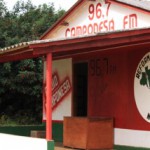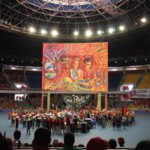A social movement’s struggle to control media
In my doctoral dissertation “Voices from the margins – People, media, and the struggle for land in Brazil” I looked into communicative processes and media practices in a subaltern social movement, the Brazilian Landless Workers Movement (MST, Movimento Sem-Terra, in the Portuguese acronym). I wanted to question the views that media technologies alone can promote a democratic and inclusive public sphere and foster insurgent mobilization. My aim was also to offer a different perspective on the interplay between media an social mobilization by looking into how a movement formed by others than educated middle classes in the West relate to media – as institutions, artefacts, and content – in their practices.
 I spent in total five months in Brazil interviewing MST militants who work with communication (press-officers, radio presenters, video activists, and media coordinators) and visiting radio stations, press-offices, as well as participating in MST’s 6th National Congress. MST was founded in 1984 by groups of rural workers and has today 1,5 million members located in twenty-four of twenty-six states in Brazil, constituting one of the biggest social movements in Latin America. The movement acts by occupying unused plots of land or land that is not being used according to legal requirements[*]. Since its first years of existence MST has put a strong effort in establishing spaces for communication among militants and with the society. The movement’s newspaper Jornal Sem-Terra has survived over thirty years and continues to be distributed in MST settlements throughout Brazil. Settlement radios broadcast with difficulties and scarce resources in areas where there is no mobile phone coverage and unstable or expensive Internet access. In the last years MST started to use social media, but not without questioning the benefits and possible threats of going digital with their communication.
I spent in total five months in Brazil interviewing MST militants who work with communication (press-officers, radio presenters, video activists, and media coordinators) and visiting radio stations, press-offices, as well as participating in MST’s 6th National Congress. MST was founded in 1984 by groups of rural workers and has today 1,5 million members located in twenty-four of twenty-six states in Brazil, constituting one of the biggest social movements in Latin America. The movement acts by occupying unused plots of land or land that is not being used according to legal requirements[*]. Since its first years of existence MST has put a strong effort in establishing spaces for communication among militants and with the society. The movement’s newspaper Jornal Sem-Terra has survived over thirty years and continues to be distributed in MST settlements throughout Brazil. Settlement radios broadcast with difficulties and scarce resources in areas where there is no mobile phone coverage and unstable or expensive Internet access. In the last years MST started to use social media, but not without questioning the benefits and possible threats of going digital with their communication.
What I consider my main conclusion is that MST succeeds in mobilizing its militancy because they have established spaces for communication that are not dependent on media such as discussion groups, regional meetings, schools, and workshops. The communicative processes that are enacted within the movement will determine which media practices will be adopted and encouraged. This is what militants call appropriation process; they consider that media are to be appropriated of in order to be used in the ways that best suit the organization. That is the reason why social media platforms are not used for narrowcasting or mobilizing, but for reaching the outside public offering an alternative narrative to that of mainstream media in Brazil. Through an appropriation process MST militants realized that social networks such as Facebook are not safe spaces where to organize and discuss internal strategies. Another concern regarding new media platforms is their immediacy, which can pose a threat to well-established processes of deliberation and discussion that are dependent on face-to-face interaction.
These findings point to the need to look for the relation between media and social mobilization from outside the West-North context. Social, political, and economical conditions such as inequality, scarcity of resources and social exclusion are determinant factors, which may completely change people’s relation to media. We can only understand the diversity and complexity of this relation once we look beyond the Western-Northern perspectives that have so far dominated media and communication as a field of knowledge.
My dissertation is available online at
http://www.diva-portal.org/smash/get/diva2:820837/FULLTEXT01.pdf
[*] According to Brazilian rural law, land should be cultivated in ways do not harm the environment and create jobs.
Paola Sartoretto,
Department of Geography Media and Communication (GMK)
Karlstad University

